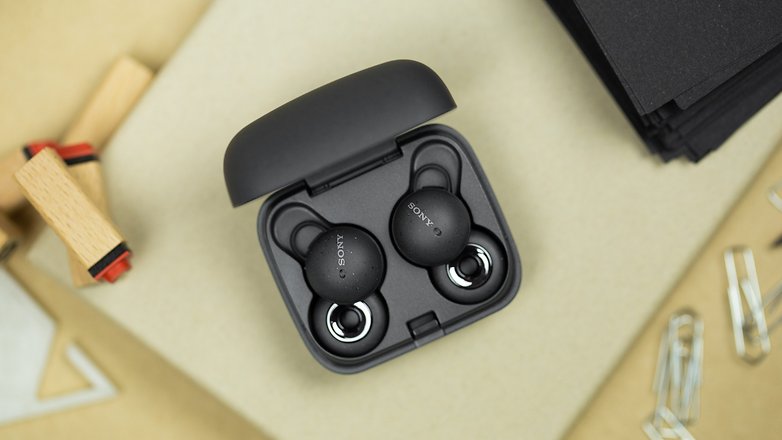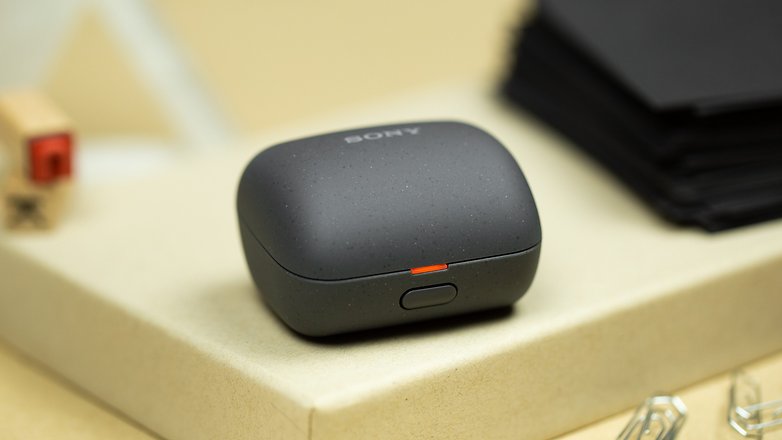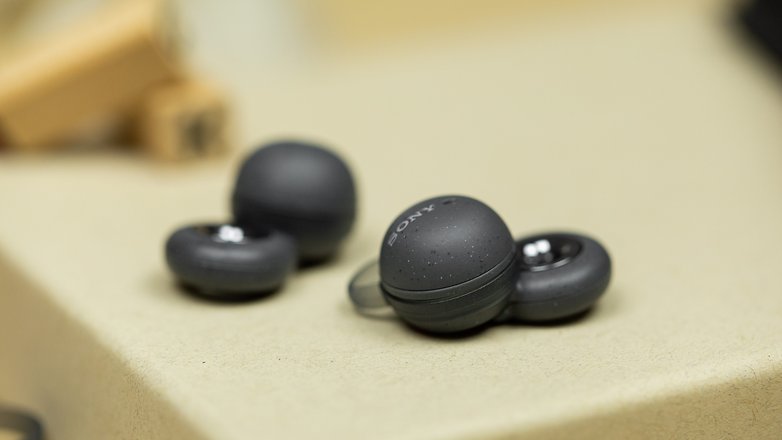Why do Sony’s LinkBuds look like recycled fidget spinners? Well, because they are the first open in-ear headphones. Means you can hear ambient noise when listening to music and podcasts without any electronic transparency modes. You can read how good it is in everyday life in the test report!
NEXTPITtv
Per
- New driver design
- Hardly noticeable in the ear
- Very compact charging case
- Exciting operation via face tap
cons
- Less flexible than ANC earbuds with transparency mode
- Little power in the bass range
- Battery life rather mediocre
- High audio bleeding
short conclusion
In my headline, I call the LinkBuds the most exciting headphones on the market right now. Because Sony is daring to do something really new with the WF-809. Sony’s idea of bringing out earbuds that let through ambient noise works really well. It’s a whole new listening experience, but at the same time it’s really impractical in many situations. While they may sound a little worse and more artificial in transparency mode, ANC headphones with transparency mode are much more flexible overall.
Although the sound is hard to compare to alternatives, the LinkBuds sound solid. You should not be open to hi-fi enjoyment or concentrated listening to music outside the home. Basses are quite lost, but the sound of the other frequencies is surprisingly clear and loud enough even in traffic.

The design of the LinkBuds looks completely different than the competition. / © NextPit
In addition to the very specific purpose, there are complaints about the not always optimal grip, the rather short battery life of 5.5 hours and the tiny, chubby charging case. True to the motto “It’s better to have than not to have”, I would personally prefer ANC headphones with a good transparency mode in traffic. As a purchase guide, I must therefore end up with a rating of 3.5 stars – not because of poor quality, but because of too limited usage scenarios.
Sony LinkBuds: design and finish
In terms of design, the headphones take a lot of getting used to and this also affects the wearing comfort. The LinkBuds fit differently than all other in-ear headphones because they basically stick to the inner walls of your ears. On the other hand, the weight is ultra-low and overall the Sony WF-809 is surprisingly compact.
Pleases
Hardly noticeable in the ear
- ultralight
- Despite the new design, it can be used without instructions
Dislike:
- Not quite secure when moving
- Adjusting it constantly leads to the touch surfaces being pressed
- The tiny charging case kept falling down during the test
I don’t think I have to explain that the LinkBuds are completely unique in-ear headphones at the time of release. The use of open drivers is forcing Sony to rethink the design and so the LinkBuds consist of two circles. They are held in place by a small fin, which comes in different sizes, and the driver, which lies on the small level in front of your auditory canal.

This is how the LinkBuds are in the ear. / © NextPit
The LinkBuds are very comfortable to wear, because you can hardly feel the buds in your ears thanks to their low weight. While the support when walking and sitting is great, the LinkBuds were too loose for my taste when exercising. I had to re-lock them frequently to avoid falling out while running.
The charging case of the LinkBuds is remarkable, which is really tiny with dimensions of 41.4 x 48.5 x 30.9 millimeters. Unlike most of the competition, it is opened with a small button and not magnetically. Opening is simple and inserting the earbuds is child’s play.

The charging case is extremely compact and comes with a button and notification LED. / © NextPit
However, the size of the case meant that the earbuds kept falling off in my test. Maybe that’s why Sony decided against magnetic protectors – they tend to pop open when earbuds fall to the ground. Despite the added security, the operation of the charging cradle is a bit too fiddly for me.
Operation and comfort features
Sony’s innovation department has also done a good job with the operation. Because in addition to touch-sensitive surfaces on the earbuds themselves, you can also simply tap your temples or cheeks. Sony’s standard application for headphones is used as an app, plus there’s wearer detection and adaptive volume control.
Pleases:
Clever face tap controls
- Adaptive volume control
- Wearer detection always cool
Dislike:
- Advanced touch controls quite buggy
I would like to point out a few things about the LinkBuds regarding controls and convenience features. Because as if the new headphone design wasn’t exciting enough, the LinkBuds offer a new type of control. Because instead of just tapping on the headphones, for example to skip a song, you can also tap on your temple or cheek after activating the “wide-area tapping”.

The “nubs” of the earbuds are touch-sensitive. / © NextPit
This looks pretty stupid in the test, but works surprisingly well. Unfortunately, Sony doesn’t let you adjust the sensitivity of this feature, which can be annoying in some situations. In the test, it often happened that the headphones switched on a song when walking or jogging. A little annoying, especially if you enjoy listening to podcasts while jogging and lose track position in the process.
The Sony LinkBuds can also automatically adjust the volume as you move through the world. The feature called “adaptive volume” regulates based on your ambient noise and thus ensures that you can always hear your surroundings clearly. The automatic works very reliably, which my test with over-ear headphones over the earbuds showed with increasing noise.

Various rubber rings allow the LinkBuds to sit securely in the ear. / © NextPit
sound quality
The sound of the Sony LinkBuds is incomparable due to the open driver design. Because the drivers have been provided with a hole to let more ambient noise to the ear. From a purely technical point of view, the headphones cover a frequency range from 20 Hertz to 20 Kilohertz and offer support for DSEE and Sony’s 360 degree audio.
Pleases:
- Solid sound in quiet environments
Sound beautifully clear and defined
- Customization options in the app
Dislike:
- Severe audio bleeding
- Basses are severely lost
- Health concerns (opinion)
The sound of the Sony LinkBuds is difficult to compare with conventional in-ear headphones. They reminded me a little of products like the Bose Frames or the Fauna Audio Glasses. Audio products that supply your ears with music rather passively and let the ambient noise through without electronic aids.
Compared to audio glasses, which transmit the sound to the ear via small, directional loudspeakers, the sound is much clearer and more defined. After all, the driver of the LinkBuds still sits in front of the ear canal. The earbuds therefore sound very decent in quiet environments, although the music clearly lacks bass. Even with activated bass boost, the LinkBuds cannot build up any real pressure in the low frequency range.

The LinkBuds drivers are circular and come with a hole. / © NextPit
Not too bad, because the LinkBuds are really great for road traffic. You feel like you’re walking around in your own film with a matching soundtrack, because the music reaches your ears out of nowhere. In noisy environments, however, one tends to turn up the volume on the headphones in order to still be able to understand podcasts or music. I would be careful here in the long run, since the tendency to crank it up to the max can be harmful to the ears in the long run. Especially since the headphones do not filter out ambient noise and their load is added.
Battery life: quite short with mini charging case
Sony specifies a runtime of 5.5 hours for the LinkBuds with active music playback. You can reach another 12 hours with the supplied charging case.
Pleases:
- Compact charging case brings 12 hours more runtime
- Quick charging
Solid runtime for a compact size
Dislike:
- Runtime is rather mediocre compared to other models
- No wireless charging
After my practical test, I was able to confirm Sony’s information on battery life. The headphones last 5.5 hours if you wear them continuously and listen to music. The headphones don’t support ANC, so there isn’t a huge impact on battery life. You can reach another 12 hours with the included charging case.

The charging case gives you 12 more hours of music enjoyment. / © NextPit
A total runtime of 17.5 hours is decent. However, the runtime of 5.5 hours is quite mediocre compared to other in-ear Bluetooth headphones. If you wear it all the time, you won’t be able to listen to music for a full working day. However, given the compact size of the earbuds, I’m happy with the battery life of the LinkBuds.
Once the LinkBuds are completely empty, they can be charged within 10 minutes so that you can listen to music for 90 minutes. Perfect if you need power for music before jogging. What is missing, however, is wireless charging. So you always have to use the USB-C port on the back to charge the headphones.
Personal conclusion
My personal conclusion of the Sony LinkBuds is a bit more negative than the reviews of my colleagues on the net. Because although I find the LinkBuds technically ingenious, I would advise most people not to buy them. Because even if the ambient noise sounds clearer and more natural via open drivers, the headphones lack a kind of plug with which I can switch off the noise if necessary.
Because it is not always practical to perceive your surroundings while wearing headphones. Be it on the plane, where the background noise is already high, or on the train, when someone is on the phone in the rest compartment. Being able to block out your surroundings is one of the most practical developments of modern headphones.
Personally, I’ve been using the OnePlus Buds Pro for a few months – with ANC and a transparency mode that’s super easy to access and the quality is okay. Depending on my needs, I can either hear what is happening around me or just ignore it. I think my point is now clear: The LinkBuds are super cool, but just too inflexible in everyday life to be really dangerous to the ANC competition.
But that’s somehow the fascination with Sony. Where else are there regular products where something new, something different is really tried out? Where smartphones cost 1,800 euros, but can stream videos with 4K resolution to the network via 5G. Or where a 1-inch variable aperture sensor is used. Sony is fighting against the monotony and that’s why the LinkBuds are very important!
Sony LinkBuds
To the device database
